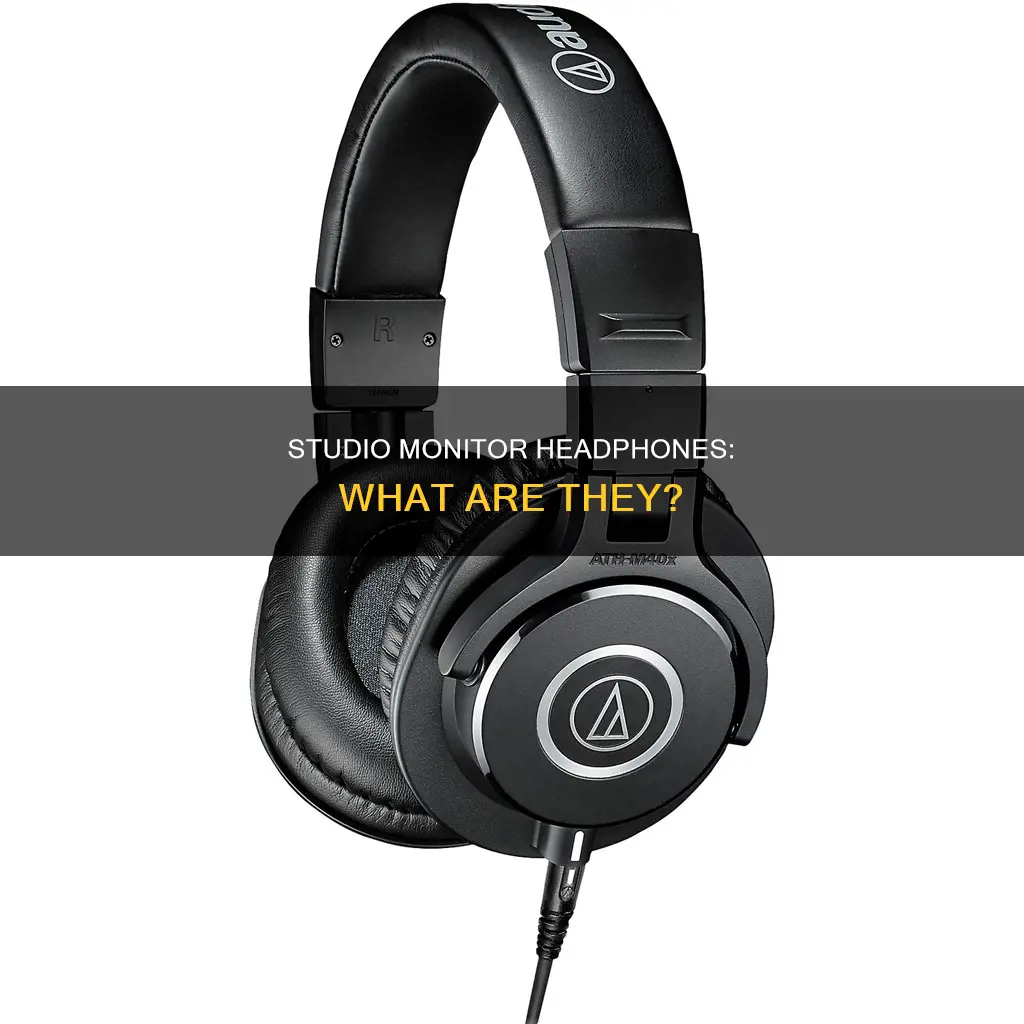
Studio monitor headphones are used in a professional studio to monitor audio being recorded or mixed. They are designed to reproduce sound as close to the original recording as possible. Studio monitor headphones are mainly used for monitoring while recording, mixing, mastering, editing, and tracking. Studio headphones are designed to exhibit a flatter frequency response than most regular headphones, so that tracks made using them will sound better when played back on a wide range of systems.
| Characteristics | Values |
|---|---|
| Purpose | Monitoring audio being recorded or mixed in a studio |
| Regular vs Monitor | Regular headphones are for casual use; studio monitor headphones are for professional use |
| Power | Require more power than regular headphones |
| Sound Isolation | Physically block outside sounds from entering |
| Frequency Response | Flat frequency response |
| Frequency Range | Wide frequency range |
| Design | More robust and comfortable |
| Bass | No boosted bass |
| High-Frequency Sounds | No high-frequency sounds |
What You'll Learn

Studio monitor headphones are used for recording and mixing
Sound isolation is a key benefit of studio monitor headphones, as they physically block outside noises by completely covering the ears, eliminating the need for noise cancellation technology. This feature is particularly useful for on-the-go users and those working in noisy environments.
Studio monitor headphones also provide a flat frequency response, allowing users to hear music as it was originally intended, without any boosted bass or high-frequency sounds. This accuracy is crucial for music producers and sound engineers, as it enables them to make precise adjustments to their mixes. The wide frequency range of these headphones ensures that all audible frequencies can be reproduced, resulting in a more immersive listening experience.
Additionally, studio monitor headphones are designed to be robust and comfortable. Their durable construction makes them ideal for extended use in studio settings, and their soft ear cups provide comfort during long recording and mixing sessions. However, they tend to be bulkier than regular headphones due to their focus on functionality rather than style.
One of the most significant differences between studio monitor headphones and regular headphones is the lack of boosted bass and high-frequency sounds. Studio monitor headphones are designed for accuracy, neutrality, and detail, which may be less appealing to those who enjoy enhanced bass or high-frequency sounds. However, for music professionals who require precise sound reproduction, studio monitor headphones are essential.
Studio monitor headphones are specifically designed for recording and mixing audio in a studio setting. They offer superior sound isolation, a flat frequency response, a wide frequency range, and a comfortable, durable construction. While they may not be suitable for casual music listening, they are indispensable tools for music producers and sound engineers seeking accuracy and precision in their work.
Juvenile Ankle Monitors: Can They Detect Drugs?
You may want to see also

They have a flat frequency response
Studio monitor headphones have a flat frequency response, meaning that all frequencies remain level across the entire range. This is in contrast to most consumer-grade headphones, which have a V or U-shaped frequency response due to elevated bass and treble frequencies.
A flat frequency response is crucial for studio monitor headphones as it allows the user to clearly hear the bass, mids, and highs without any "colouration" (boosting or reduction). This is important as it enables users to accurately manipulate audio frequencies in their digital audio workstations.
The flat frequency response of studio monitor headphones means that they reproduce sound as close to the original recording as possible. This can bring new life to your music library, as you may hear things that your regular headphones omitted. For example, you may notice instruments that you didn't know were included in a song.
Studio monitor headphones typically have a frequency response range of 20 to 20,000 Hz, which is the standard audible frequency range for humans. However, some studio monitor headphones can reproduce frequencies beyond this range.
A wide frequency response range is advantageous as it allows studio monitor headphones to reproduce frequencies used in the actual recording and emit deeper bass and clearer highs. This results in a better listening experience and more accurate sound reproduction.
The flat frequency response of studio monitor headphones may not be preferred by casual listeners, who often enjoy the boosted bass and enhanced high frequencies of consumer-grade headphones. However, for those who value clarity and accurate sound reproduction, studio monitor headphones offer a superior listening experience.
Studio monitor headphones are designed for audio professionals and are built to be robust and comfortable, with softer ear cups that can be worn for extended periods without discomfort or fatigue. They may be bulkier and less stylish than consumer-grade headphones, but their focus is on practicality and functionality rather than aesthetics.
In summary, the flat frequency response of studio monitor headphones is a key feature that sets them apart from consumer-grade headphones. It enables accurate sound reproduction, clear hearing of all frequencies, and precise audio manipulation. While the flat frequency response may take some getting used to for casual listeners, it is highly valued by audio professionals and those seeking a detailed and accurate listening experience.
Finding Monitors with VESA Mounts: A Simple Guide
You may want to see also

They have a wide frequency range
Studio monitor headphones have a wide frequency range, which is an advantage over regular headphones. The human ear can detect frequencies from 20 Hz to 20,000 Hz, and good studio monitor headphones can reproduce all of them; regular headphones usually don’t cover the full range.
Studio monitor headphones are designed for audio professionals, such as musicians and sound engineers, who require a wide frequency response and accuracy in the reproduction of sound. The wide frequency range of studio monitor headphones allows them to reproduce frequencies within (and sometimes beyond) the standard 20 – 20,000 Hz range that the human ear can detect.
The wide frequency range of studio monitor headphones also enables them to emit deeper bass and clearer highs. This results in a better listening experience, as it allows the headphones to reproduce frequencies that were used in the original recording.
Additionally, studio monitor headphones with a wide frequency range can be beneficial for mixing audio. Their neutral frequency response, characterised by minimal emphasis or de-emphasis on certain frequencies, allows users to clearly hear the bass, mids, and highs without any "colouration" (boosting or reduction). This makes studio monitor headphones ideal for mixing and mastering audio, as users can accurately manipulate audio frequencies in their digital audio workstations (DAWs).
Furthermore, the wide frequency range of studio monitor headphones can enhance the overall audio quality. The ability to reproduce a broader range of frequencies results in a more immersive and detailed listening experience. This is particularly advantageous for musicians and audio engineers who require precise sound reproduction for critical listening and analysis.
In summary, the wide frequency range of studio monitor headphones is a significant advantage, offering improved audio accuracy, detailed sound reproduction, and a more immersive listening experience. This makes them a valuable tool for audio professionals, ensuring that the sound they hear is as close as possible to the original recording.
Performance Management: Ongoing Monitoring Strategies for Success
You may want to see also

They are more robust and comfortable
Studio monitor headphones are designed with comfort in mind, as they are intended for extended use in studio settings. They are also built to be more durable than regular headphones.
Studio monitor headphones are designed to be worn for long periods of time. As such, they are manufactured with comfort in mind. They tend to have softer ear cups, which allow users to wear them for hours without discomfort or fatigue. They are also designed to be more robust than regular headphones, as they are built for studio use and are passed around and used by various people. Studio monitor headphones are made with stronger and more durable materials and have thicker and longer cables that can resist tugging, pulling, and tangles.
Studio monitor headphones are used for audio recording and mixing in a studio setting. They are used by sound professionals, musicians, and artists. They are designed to reproduce sound as close to the original recording as possible, with a neutral frequency response. This means that they do not have a boosted bass or high-frequency sounds, resulting in a more accurate listening experience.
While studio monitor headphones offer a more accurate and detailed listening experience, they may not be suitable for everyone. They are typically bulkier and heavier than regular headphones, and some users may prefer the bass-rich sound of regular headphones. Additionally, studio monitor headphones may require more power than regular headphones, and they may not have extra features like wireless connectivity or noise-cancelling technology.
Uninstall Disk Drill Smart Monitoring: A Step-by-Step Guide
You may want to see also

They don't have boosted bass or high-frequency sounds
Studio monitor headphones are designed to reproduce sound as close to the original recording as possible. They are used for monitoring while recording and mixing audio.
One of the key differences between studio monitor headphones and regular headphones is that studio monitor headphones do not have boosted bass or high-frequency sounds. Studio monitor headphones are made for accuracy, detail, and neutrality. They reproduce what your music sounds like without modifying anything. This means that you will only hear that thud-thumping bass if it was recorded that way.
The lack of boosted bass and high-frequency sounds in studio monitor headphones can be a disadvantage if you are someone who enjoys a ton of bass. In that case, regular headphones would be a better option, as they are designed to enhance your listening experience by emphasising bass and high-frequency sounds.
However, the lack of boosted bass and high-frequency sounds in studio monitor headphones can also be considered an advantage. This is because it allows for a more accurate listening experience, as no part of the sound spectrum is elevated. You will hear details that you would otherwise miss if you were using bass-boosted headphones.
Additionally, studio monitor headphones usually have a wide and flat frequency response. This means that they are capable of reproducing frequencies within, and sometimes even beyond, the standard 20-20,000 Hz range that humans can hear. A flat frequency response means that all frequencies remain level across the entire range, resulting in a neutral-sounding output. This is in contrast to regular headphones, which often have a V or U-shaped frequency response due to elevated bass and treble frequencies.
Overall, the lack of boosted bass and high-frequency sounds in studio monitor headphones is a feature that is designed to provide accuracy and neutrality in the reproduction of sound. While this may not be appealing to those who prefer enhanced bass, it can offer a more detailed and accurate listening experience for those who value sound quality and clarity.
Replacement Monitor Screens: Where to Buy Them?
You may want to see also
Frequently asked questions
Studio monitor headphones are used in a professional studio to monitor the audio being recorded or mixed. They are designed to reproduce sound that is as close to the original recording as possible.
Studio monitor headphones have a wide and flat frequency response, no boosted bass, and are usually more comfortable and robust than regular headphones. Studio monitor headphones are also designed for studio use and audio accuracy, while regular headphones are designed for casual use and enhanced listening experiences.
Studio monitor headphones offer sound isolation, a flat frequency response, a wide frequency range, a robust and comfortable design, and accurate sound reproduction. They are ideal for musicians, sound engineers, and audio professionals who require detailed and accurate sound monitoring.
Studio monitor headphones are not typically recommended for casual music listening, as they may require more power and lack extra features like wireless connectivity or noise-canceling technology. They are designed for audio accuracy and detail rather than enhanced bass or high-frequency sounds. However, they can be a good choice for those who prefer neutral and clear sounds.
Some popular studio monitor headphones include the Audio-Technica ATH-M50x, Beyerdynamic DT 900 Pro X, Sennheiser HD 490 Pro, and Sony MDR-7506. These headphones offer a combination of sound quality, comfort, and durability, making them suitable for studio use and audio production.







